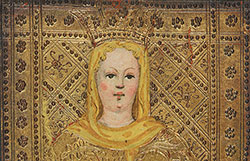
Visconti-Sforza Tarot Cards.
Purchased by J. Pierpont Morgan (1837-1913) in 1911.
35 cards : heavy cardboard, illuminated ; 173 x 87 mm
Executed by or for a member of the Visconti-Sforza family (emblems and devices of both families found intermingled on the cards, i.e., the Sforza three interlinked diamond rings, the Visconti ducal crown of Milan with palm and laurel), probably Francesco Sforza (d. 1466), most likely after his triumphal entry as Duke of Milan 25 March 1450; the patrician family Bon from Venice?, as suggested by heraldic elements in certain cards (parti de gueles et d'argent) and a haloed lion holding a book on the shield of the King of Swords (M.630.22); Count Alessandro Colleoni of Bergamo (d. 1900); purchased by J. Pierpont Morgan (1837-1913) through Hamburger Frères, Paris, in 1911; by descent to J.P. Morgan (1867-1943).
Tarot cards; 33 illuminated in Milan, Italy, ca. 1450, and 3 replacement cards (M.630.5 - Temperance; M.630.8 - Fortitude; and M.630.13 - The Sun) illuminated ca. 1480.
Decoration: 8 court cards and 15 trump cards with figural representations, 12 decorated pip (numerical) cards.
Artist: The original cards have been attributed to Francesco Zavattari, while more agree with the attribution to Bonifacio Bembo. The replacement cards have traditionally been attributed to the Cremonese artist Antonio Cicognara, an attribution questioned by Dummett (1980), who suggests instead an artist from Ferrara or (Dummett 2007) Benedetto Bembo (brother of Bonifacio) and proposes that they were not replacements but part of the original set as designed by the Bembo workshop. Bauer-Eberhardt (1997) advances Franco dei Russi (or de' Russi) as the artist of these later cards, attribution accepted by the exhibition catalogue Tarots enluminés (2021).
A complete pack of tarot cards consists of seventy-eight cards; the thirty-five cards in the Pierpont Morgan Library, twenty-six in the Accademia Carrara in Bergamo, and thirteen owned by the Colleoni family of Bergamo form one of the most complete sets of 15th cent. painted tarot cards of Italian origin.
Previously stored in late 14th-century French cuir bouilli casket, said to be from the Pères de la Merci de Toulouse, with arms on an escutcheon: an angel confronting a shield bearing a cross; casket decorated with scenes of chivalry: a lady showing her heart to a knight, and a knight accepting the heart and giving the lady a ring; the casket was purchased by J.P. Morgan (1867-1943) on 7 November 1919 from Léon Gruel, Paris.


Fifteenth-century painted tarot cards of Italian origin are exceedingly rare, and no complete deck has survived. The thirty-five cards in the Morgan Library, twenty-six in the Accademia Carrara in Bergamo, and thirteen owned by the Colleoni family of Bergamo form the most complete and one of the most important sets known. A complete pack consisted of seventy-eight cards: twenty-one trump (tarot) cards, one wild card (the Fool), and fifty-six cards divided into four fourteen-card suits (cups, staves, coins, and swords). Each suit was made up of ten number cards plus four picture cards (page, knight, queen, and king).
In the Renaissance tarot cards were not the paraphernalia of fortune tellers but were used in a normal card game enjoyed by the nobility. The game, the rules of which have been lost, was invented in northern Italy, probably in Milan or Ferrara, in the second quarter of the fifteenth century. The astrological use of tarot cards derives from scholarly misinformation published by Antoine Court de Gébelin in 1781. He traced their origin to ancient Egypt, identifying them with the Book of Thoth, the scribe of the Egyptian gods.
All three of the earliest decks have been attributed to the Cremonese painter and illuminator Bonifacio Bembo (active 1440-80). More recently, however, the Morgan deck has been given to Francesco Zavattari (active 1417-83), the slightly older illuminator and fresco painter in whose circle Bembo worked. Six cards in a different style, which are apparently replacements, were painted by Antonio Cicognara at the end of the fifteenth century.
This deck may have been made for Bianca Maria Visconti and Francesco Sforza, whose betrothal (1432) and marriage (1441) united the two families. In any case the emblems of both families, intermingled on the cards, reveal that they were made for some member of the Visconti-Sforza family.